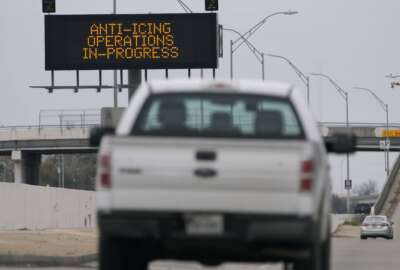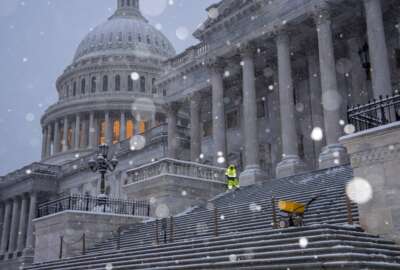77 House lawmakers press USPS to adopt stricter extreme heat protections for employees
Lawmakers are calling on USPS to implement OSHA's proposed heat rule because five of its employees have died in heat-related incidents since 2018.
Scores of House Democrats are calling on the Postal Service to adopt stricter workplace protections for extreme heat.
The 77 House Democrats are calling on USPS to “immediately implement” the standards in the workplace heat rule the Occupational Safety and Health Administration (OSHA) proposed last month.
“Proactively implementing this rule would save lives by ensuring that your workforce is protected with the most up-to-date heat safety standards,” the lawmakers wrote in a letter to Postmaster General Louis DeJoy.
The proposed rule, if finalized, would be the nation’s first-ever federal heat rule.
It would propose employers nationwide to provide water and rest breaks for employees exposed to high temperatures while they work once temperatures reach 80 degrees. At 90 degrees, OSHA proposes employers provide a minimum 15-minute break every two hours.
OSHA expects the proposed rule would cover 36 million workers who work indoors and outdoors. However, there is no proposed implementation date, because OSHA is still reviewing the proposed rule.
The lawmakers are calling on USPS to implement the OSHA heat rule because five of its employees have died in heat-related incidents since 2018.
The most recent case happened in June, when Wendy Johnson, a letter carrier in Fayetteville, North Carolina, died shortly after a shift working in a vehicle without air conditioning in 95-degree weather.
“While the standards in the proposed rule are currently optional, the final rule will have the effect of law when published by OSHA,” the members wrote. “In the interim, the Postal Service is still required to protect its workers from extreme heat and can guarantee that they are meeting this duty with these standards.”
House Oversight and Accountability Committee Chairman Jamie Raskin (D-Md.), along with Reps. Greg Casar (D-Texas) and Judy Chu (D-Calif.), are leading the letter.
USPS employees experienced 1,332 heat-related accidents since fiscal 2022, according to a report by its inspector general’s office. The report says 54% of cases led to missed work time and potential injuries — such as heat exhaustion or heat stroke.
The agency’s Kansas–Missouri district had 136 heat-related accidents during this period — the most of any USPS district. The Arizona – New Mexico district had the second highest with 118 accidents, or about one accident per 60 letter carriers.
Simon Storey, USPS vice president of human resources, clarified to the IG’s office that the data it provided only indicated whether a heat-related incident was “OSHA recordable,” meaning an employee required medical care, days away from work or restricted duty.
“The data provided by the USPS and used in this section did not specify that incidents resulted in a diagnosed medical condition and disability from work,” Storey told the IG’s office.
Postmaster General Louis DeJoy, in an exclusive interview last year, told Federal News Network, in response to questions about the heat-related death of a letter carrier in Houston, that “we care about our employees, we have processes to protect them.”
DeJoy said in the wide-ranging, 90-minute interview that he has repeatedly stressed a workplace safety message to the tens of thousands of USPS supervisors he’s met.
“One of the things I tell them is, ‘Hey, treat everybody like you want to be treated yourself.’ And that’s just not on a good day, it’s when you have a bad day, you’re in an emergency and all that stuff. It’s an effort to do that,” DeJoy said.
“I’ve worked in commercial industries — the pressure is more,” DeJoy, a former CEO of New Breed Logistics, added. “It’s not here prolifically throughout the whole organization. Is there an instance here, and an instance there? Well probably, yes. We have a methodology of this stuff rising up within the organization, but that’s not the majority of what goes on. It’s not even close to what goes on in the whole organization.”
DeJoy has repeatedly highlighted that ongoing USPS network and fleet modernization plans will give employees more modern amenities.
In March 2022, when the Biden administration and Congress scrutinized USPS plans for its next-generation delivery vehicle (NGDV) fleet, the postmaster general said USPS employees cannot wait any longer for new vehicles.
Many of its 190,000 delivery vehicles on the road are more than 30 years old, and the iconic USPS Long Life Vehicle lacks lack basic safety features that are standard in most vehicles today — including airbags and air conditioning.
“I’m not saying that we don’t have things that we need to work on to get better — there is. Part of it is having very, very deliberate processes, and having good workplaces, having modern vehicles — having all the other stuff that this organization was put in a position not to have by the stakeholders around it — that we’re trying to fix. And I can assure you, the safety of our employees is part of it. It’s of primary importance, but it comes from fixing all this stuff,” DeJoy said in the July 2023 interview.
USPS implemented an OSHA-approved Heat Illness Prevention Program in 2018, which requires all employees to watch a heat stress recognition and prevention video and answer questions throughout the video. Employees must attend a mandatory safety talk on heat stress.
However, the IG office found USPS facility management, in some cases, incorrectly logged in the agency’s online HR system that absent employees completed mandatory heat training.
In one case, the report found a facility manager in Louisiana certified that 39 letter carriers completed the training — even though timecard records show 44% of the carriers listed weren’t working that day.
In another example, a facility manager in the Kansas-Missouri district logged 137 carriers as having completed the heat safety training — but time and attendance records show 37% of employees were absent that day.
Politico first reported last December that the National Association of Letter Carriers alleges USPS facility managers have falsified records that thousands of employees completed heat-safety training in at least 10 states.
About 33% of the nearly 50 employees USPS OIG auditors interviewed said they didn’t watch a mandatory heat-stress recognition and prevention video in the past year — although their supervisors logged some of them as having completed the training.
More than 80% of sites the inspector general’s office toured didn’t display the heat program policy, and a third of them didn’t display a heat illness poster showing the symptoms of heat exhaustion and heat stroke.
Overall, the USPS OIG found the agency’s management of extreme hot and cold temperature conditions was similar to other agencies and mailing companies.
On days with extremely hot temperatures, USPS facility management provides letter carriers with water, ice pops, cooling towels, additional breaks, and electrolyte packets to add to their water bottles.
USPS headquarters also requires facility management to give employees postcards, stickers in carrier vehicles and laminated badges promoting heat stress awareness.
USPS facility management is also required to inspect USPS vehicle fans during all preventive maintenance inspections.
The inspector general’s office recommends USPS ensure supervisors only certify that employees who are present for heat training are marked as having completed the training, and that USPS headquarters set expectations to facility management for conducting the required Heat Illness Prevention Program training video in group settings.
Storey told the IG’s office USPS generally agreed with the report’s recommendations.
However, he said USPS was unable to implement the IG office’s recommendation to let employees complete the training from the handheld scanners they carry with them on their routes.
Storey told the IG’s office that the training materials are too large, and would have to be shorted and modified to work on the handheld devices.
Copyright © 2025 Federal News Network. All rights reserved. This website is not intended for users located within the European Economic Area.
Jory Heckman is a reporter at Federal News Network covering U.S. Postal Service, IRS, big data and technology issues.
Follow @jheckmanWFED






